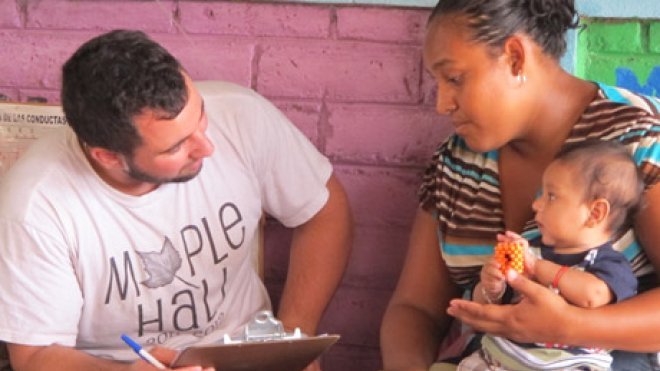Opting for a Service-Centered Spring Break
An alternative to typical spring break trips, these community service projects delivered 53 students from New Orleans to Nicaragua to lend a hand

For many college students, spring break offers a relaxing reprieve from classes to catch up on homework or take a trip to a tropical locale. But for 53 Roger Williams students, their respite from time in class was dedicated to rolling up their sleeves to help others in need. Via three campus organizations, these students participated in four Alternative Spring Break service programs organized by RWU’s chapters of the Foundation for International Medical Relief for Children (FIMRC), Habitat for Humanity and the Intervarsity Christian Fellowship (IVCF). Although diverse groups with seemingly little in common, they shared experiences of new encounters with different environments and people, as well as a novel, hands-on approach to community service.
Where did they go?
From Central America to the Caribbean to Alabama and New Orleans’ Ninth Ward, students traversed the Western hemisphere to help local communities rebuild or assist with health care. Sponsoring two trips this semester, RWU’s FIMRC chapter sent students to Limón, on the southwestern coast of Nicaragua, and to Restauración, Dominican Republic. Meanwhile, the Habitat for Humanity group traveled to Birmingham, Ala., and IVCF returned to New Orleans – the student organization’s focus during Alternative Spring Break for the last four years.
What did they do?
With FIMRC’s spotlight on pediatric and maternal health in poverty-stricken locales, both University trips concentrated on providing health education for the communities around the sponsored clinics. In Nicaragua, students – guided by Assistant Professor of History Autumn Quezada-Grant – assisted in the care of individuals with diabetes, followed the local nurse on home visits to pregnant women, and taught schoolchildren about topics such as washing their hands, causes of respiratory illnesses, and why clean water is so important to their health.
Accompanied by Nancy Soukup, the University multifaith chaplain, FIMRC students volunteering at the Dominican Republic clinic worked with young girls, empowering them to take control of their bodies via basic tips for caring for themselves and when to say “no.”
In Alabama, Habitat for Humanity volunteers built a house for a Desert Storm veteran who had lost his home to a tornado. Megan Dumaine ’09, an advisor for RWU Habitat for Humanity and coordinator of residence education, described the students’ quick progress constructing the exterior and interior walls and the roof in only a few days: “We made a visible difference by the end of the week.”
And nearby in New Orleans, students from IVCF joined the Journey Ninth Ward Church to improve the neighborhood surrounding their church by stripping and repainting houses. Even more than eight years after Hurricane Katrina devastated lower New Orleans, the area still needs a lot of work, noted Tim Clarkin ’14, an engineering major and IVCF treasurer.
What were some memorable moments?
Making a positive impact on a struggling community has its anticipated rewards, but it can be the more intimate and unexpected interactions with the individuals the students work with that transform the experience into something really memorable. For Quezada-Grant, that happened in Nicaragua while watching film production (individualized) major Nickolas Palermo ’15 (who serves as president of both RWU FIMRC and the film club) teach the local children how to use the film equipment he had brought to document the students’ work through FIMRC.
“They’re taught reading, math, and it’s all memorization,” she said. “But they’re not taught art. They’re not taught music.”
An unforeseen part of their experience while rehabilitating a house still marred by Katrina became a highlight of the trip for Clarkin and his group. While fixing up the house for three days, it’s owner, Gary, shared the story of his harrowing adventure of being stranded during Katrina, as well as some words of wisdom, with the students who helped him make his home ship-shape. “You got him talking, and he would not stop. He would just keep going,” Clarkin recalled with amusement.
Why are experiences like these so valuable?
Service learning projects are key to developing a well-rounded college experience – and align with the University’s core values of commitment to community through service, promotion of civil discourse and appreciation of global perspectives. Soukup notes that classroom learning can only provide part of an education – eventually, everyone must venture into the world and experience it, whether a business major studying a marketing strategy or a history major examining Latin America.
“It’s vital for students to take trips that cross boundaries they have not thought about crossing before,” Soukup emphasizes, adding that becoming immersed in a new community – whether a few states away or across the equator – will stimulate an internalization of how one can bring home an attitude of service to one’s own community.
View a slideshow below from some of this year’s Alternative Spring Break trips: